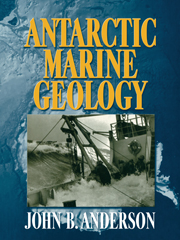Book contents
CHAPTER 1 - Antarctica's Environment
Published online by Cambridge University Press: 06 December 2010
Summary
This chapter introduces the reader to the various components of Antarctica's glacial, atmospheric, and oceanographic environment. It is not intended as an in-depth treatment of these subjects. Rather, this chapter is intended to provide marine geologists with sufficient information to focus on and solve problems related to sedimentary processes and to examine the stratigraphic record as it relates to changes in the Antarctic environment. It is also intended to provide the information needed to plan and execute successful marine geologic and geophysical expeditions.
ANTARCTICA's ROLE IN THE GLOBAL ENVIRONMENT
Isolated from other continents by the Southern Ocean (oceans south of ∼60° S), Antarctica is the only continent that experiences a true polar climate. The Antarctic Ice Sheet is almost as large as it was during the last glacial maximum, containing at least 80% of its previous volume (Denton and Hughes, 1981). Thus, Antarctica provides a modern setting in which to study “Ice Age” Earth. Antarctica claims a long history of Cenozoic glaciation and has played a key role in regulating world climate, oceanography, and eustasy for most of this geologic era.
Antarctica's lithosphere, atmosphere, cryosphere, hydrosphere, and biosphere are closely linked and have been for much of the continent's glacial history, but the continent has not always been glaciated. During the Cretaceous, the coastal regions of Antarctica supported lush, temperate forests inhabited by a wide diversity of animals. At that time, the continent was situated at a latitude similar to southern South America. As Antarctica drifted away from the other Gondwana continents and toward the south, its climate cooled and daylight hours became more seasonally distributed.
- Type
- Chapter
- Information
- Antarctic Marine Geology , pp. 1 - 27Publisher: Cambridge University PressPrint publication year: 1999
- 1
- Cited by



